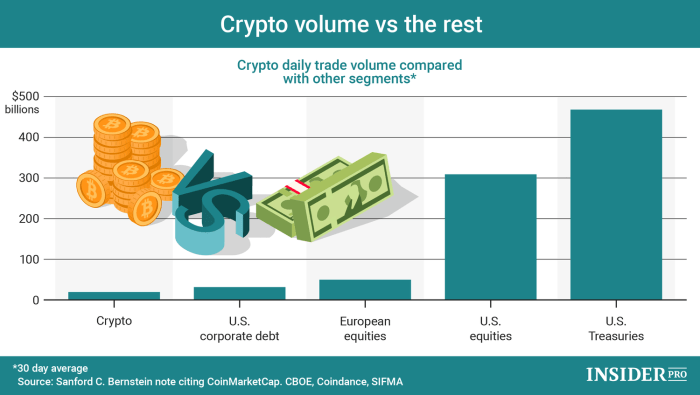
Embark on a journey through the unpredictable world of cryptocurrency market volatility, where fortunes are made and lost in the blink of an eye. Brace yourself for insights and strategies to thrive amidst the chaos of digital assets.
Market volatility in cryptocurrency refers to the rapid and unpredictable price fluctuations in the digital asset market, influenced by various factors such as market sentiment, regulatory developments, and speculative activities. This volatility impacts investors and traders, presenting both risks and opportunities in equal measure.
Overview of Market Volatility in Cryptocurrency

Market volatility in cryptocurrency refers to the rapid and unpredictable price fluctuations that occur within the digital asset market. This volatility can result in significant price swings within a short period, presenting both opportunities and risks for investors and traders.
Factors Contributing to Market Volatility
- The lack of regulation: Cryptocurrency markets are decentralized and largely unregulated, leading to susceptibility to external factors and market manipulation.
- Market sentiment: Speculation, news, and social media can heavily influence the sentiment of investors, causing sudden shifts in buying and selling behavior.
- Liquidity constraints: Cryptocurrency markets can experience liquidity issues, making it easier for large buy or sell orders to impact prices significantly.
- Market capitalization: The relatively small market cap of many cryptocurrencies makes them more susceptible to price volatility compared to traditional assets.
Impact on Investors and Traders
- Opportunity for high returns: Market volatility can create opportunities for traders to profit from price fluctuations through active trading strategies.
- Risk of significant losses: On the flip side, the high volatility in cryptocurrency markets also poses a risk of substantial losses for investors who are not prepared for sudden price swings.
- Emotional decision-making: The intense volatility in cryptocurrency markets can lead to emotional decision-making by investors, causing them to buy or sell based on fear or greed rather than rational analysis.
- Increased market uncertainty: The unpredictable nature of market volatility in cryptocurrencies can create uncertainty and make it challenging for investors to predict future price movements accurately.
Causes of Market Volatility in Cryptocurrency
Cryptocurrency market volatility can be influenced by a variety of factors that contribute to price fluctuations, uncertainty, and rapid changes in value. Let’s delve into some of the key causes of this volatility.
External Factors Influencing Market Volatility
External factors such as global economic conditions, geopolitical events, and technological advancements can significantly impact the cryptocurrency market. For example, regulatory changes, government policies, and macroeconomic trends can all contribute to sudden shifts in cryptocurrency prices.
Role of Speculation and Market Sentiment
Speculation and market sentiment play a crucial role in driving volatility in cryptocurrencies. Investor perceptions, media coverage, and social media trends can create a frenzy of buying or selling activity, leading to extreme price fluctuations based on speculation rather than underlying fundamentals.
Impact of Regulatory Developments
Regulatory developments have a profound impact on market volatility in the cryptocurrency space. News of potential regulations, bans, or restrictions can trigger panic selling or buying among investors, causing prices to swing dramatically. Uncertainty surrounding the legal status of cryptocurrencies in different countries can also contribute to market volatility.
Historical Trends of Market Volatility in Cryptocurrency
Market volatility in the cryptocurrency space has been a defining characteristic since the inception of Bitcoin. Let’s explore some of the significant events that have shaped the historical trends of market volatility in cryptocurrencies.
Examples of Significant Market Volatility Events
- In 2013, the price of Bitcoin surged from around $13 to over $1,100 before crashing back down to $200, marking one of the first major price swings in the cryptocurrency market.
- The Mt. Gox exchange collapse in 2014 resulted in a sharp decline in Bitcoin’s price, causing panic among investors and leading to increased market volatility.
- The 2017 bull run saw Bitcoin reaching an all-time high of nearly $20,000 before experiencing a significant correction, showcasing extreme price volatility.
Evolution of Market Volatility
- As the cryptocurrency market has matured, we have seen a gradual decrease in the level of volatility, with price movements becoming less erratic compared to the early days of Bitcoin.
- Increased regulation and institutional involvement have also contributed to a more stable market environment, reducing the frequency of extreme price fluctuations.
Comparing Volatility Across Different Cryptocurrencies
- Ethereum, the second-largest cryptocurrency by market capitalization, has historically exhibited higher volatility compared to Bitcoin, often experiencing more significant price swings in shorter time frames.
- Altcoins, or alternative cryptocurrencies, are generally known to be more volatile than established coins like Bitcoin and Ethereum, as they are often subject to speculative trading and have lower liquidity.
Strategies to Navigate Market Volatility in Cryptocurrency

Cryptocurrency markets are known for their high volatility, presenting both opportunities and risks for traders and investors. In order to navigate this volatility effectively, it is crucial to employ strategic risk management techniques, including hedging and technical analysis.
Risk Management Strategies
- Diversification: Spreading investments across different cryptocurrencies can help reduce overall risk exposure.
- Stop-loss Orders: Setting predetermined price levels at which to automatically sell can limit potential losses.
- Position Sizing: Adjusting the size of positions based on risk tolerance can help protect against significant losses.
Hedging in Cryptocurrency
Hedging involves taking offsetting positions to reduce the risk of adverse price movements. In the context of cryptocurrency, this can include using futures contracts or options to protect against downside risk while still allowing for potential gains.
Role of Technical Analysis
Technical analysis involves studying past market data, primarily price and volume, to forecast future price movements. By identifying patterns and trends, traders can make more informed decisions on when to enter or exit positions, thus managing market volatility more effectively.
Impact of Market Volatility on Market Research
Market volatility in the cryptocurrency sector can significantly impact the accuracy and reliability of market research. The unpredictable price fluctuations and rapid changes in market trends make it challenging for researchers to gather and analyze data effectively.
Challenges of Conducting Market Research in a Highly Volatile Cryptocurrency Market
- Difficulty in predicting market movements: With prices constantly shifting, it becomes hard to forecast future trends accurately.
- Lack of historical data: Volatility can distort the data analysis, making it challenging to identify patterns or trends.
- Risk of misinformation: False signals due to market volatility can lead to incorrect conclusions in research findings.
Potential Opportunities Due to Market Volatility in Cryptocurrencies
- Arbitrage opportunities: Market volatility creates price disparities between exchanges, allowing for profitable arbitrage opportunities.
- Increased demand for market analysis: As volatility rises, the need for accurate and timely market research also grows, presenting opportunities for market research firms.
- Innovation in research methodologies: Researchers may develop new tools and techniques to adapt to the dynamic nature of the cryptocurrency market.
As we conclude this discussion on market volatility in cryptocurrency, remember to stay informed, stay vigilant, and adapt your strategies to navigate the ever-changing landscape of digital assets. Embrace the volatility, harness its power, and pave your way to success in this dynamic market environment.
Question Bank
What are the main factors contributing to market volatility in cryptocurrency?
The main factors include market sentiment, regulatory changes, speculative trading, and external economic events.
How can investors navigate market volatility in cryptocurrency?
Investors can employ risk management strategies, diversify their portfolios, and stay informed about market trends to navigate volatility effectively.
Is market volatility in cryptocurrency a risk or an opportunity?
Market volatility presents both risks and opportunities, depending on how investors adapt their strategies to capitalize on price fluctuations.




